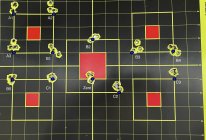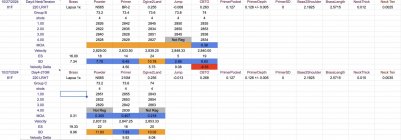I tested 3 different configurations today for my 300 PRC.
- Barrel is 30" and has bout 200 rounds before the tests.
- Lapua brass, 1x fired, annealed (Annie), trimmed, chamfered, deburred.
- Brass is cleaned by an Ultrasonic Cleaner and neck is lubed with NeoLube2.
- Powder is N565, measured by FX-120i.
- Primers are seated with K&M seating tool (with Gauge).
- All bullets are seated at jam. Berger 220 LRHT.
Group A's (in photo)
- ES/SD and groups are not good so please ignore
Group B's (in photo)
- Primers BR-2
- Neck turned down to 0.012"
- Neck tension 0.0025"
- Decent ES/SD but does not group well.
- The groups were much tighter when the neck tension was 0.0035" and neck was not turned. But ES/SD were higher as well (with virgin brass).
Group C's (in photo)
- Primers 210M
- Neck has not been turned
- Neck tension 0.0035"
- Higher ES/SD but appears to group well
Do you think I can pick a charge in B and adjust seating depth to get it to group like C? Or should I try to get ES/SD down with C?


- Barrel is 30" and has bout 200 rounds before the tests.
- Lapua brass, 1x fired, annealed (Annie), trimmed, chamfered, deburred.
- Brass is cleaned by an Ultrasonic Cleaner and neck is lubed with NeoLube2.
- Powder is N565, measured by FX-120i.
- Primers are seated with K&M seating tool (with Gauge).
- All bullets are seated at jam. Berger 220 LRHT.
Group A's (in photo)
- ES/SD and groups are not good so please ignore
Group B's (in photo)
- Primers BR-2
- Neck turned down to 0.012"
- Neck tension 0.0025"
- Decent ES/SD but does not group well.
- The groups were much tighter when the neck tension was 0.0035" and neck was not turned. But ES/SD were higher as well (with virgin brass).
Group C's (in photo)
- Primers 210M
- Neck has not been turned
- Neck tension 0.0035"
- Higher ES/SD but appears to group well
Do you think I can pick a charge in B and adjust seating depth to get it to group like C? Or should I try to get ES/SD down with C?


Attachments
Last edited:












